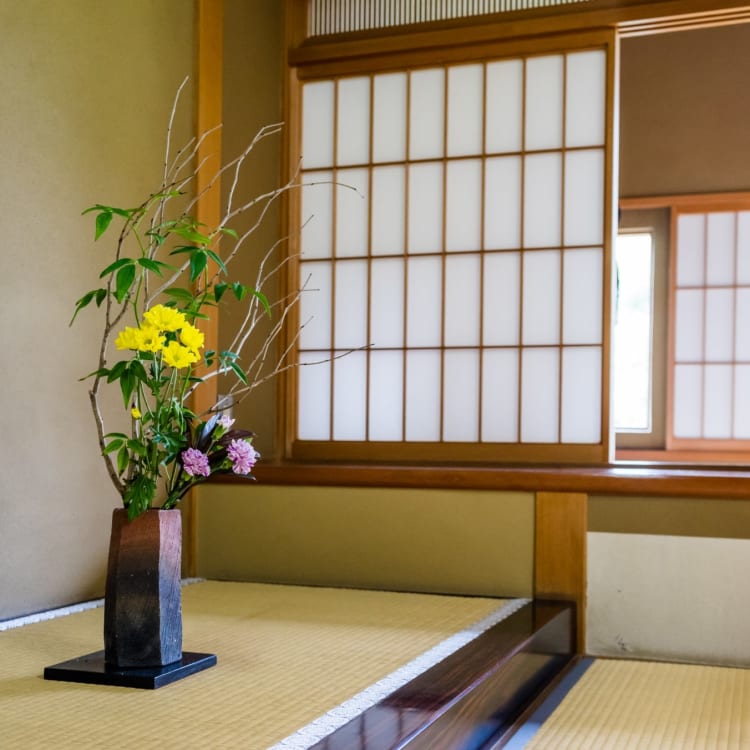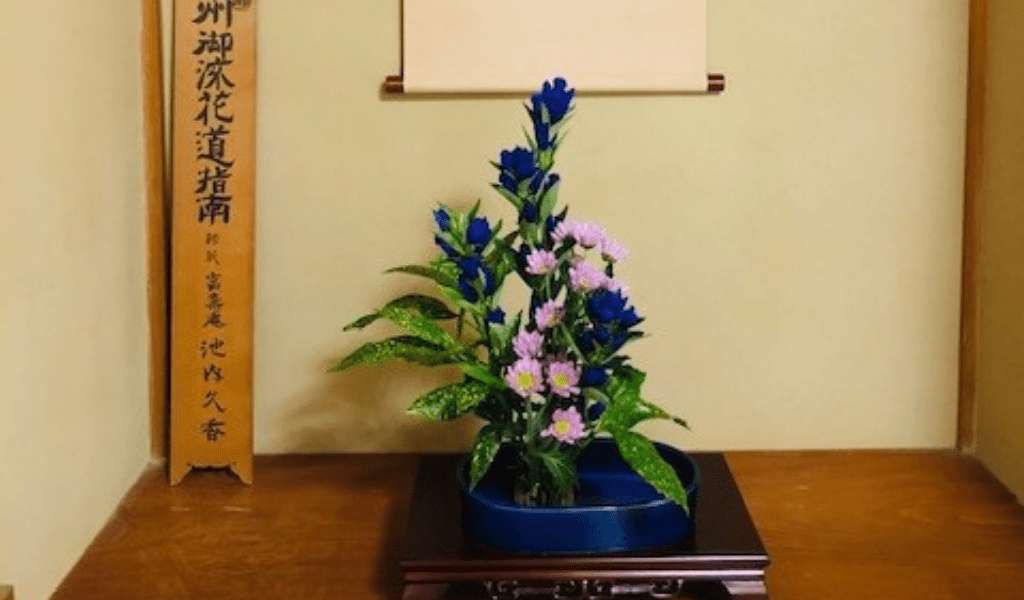
Masters Series: Part Two The Art of Ikebana
Here we speak to licensed ikebana teacher Kikuko Akimune , who belongs to the Koshu-ryu school of ikebana, a 120-year-old style originating in Nara, about the history of the artform and its ties to Zen Buddhism and how it has evolved and is practiced today. Running ikebana classes for guests at one of Kyoto’s luxury hotels, as well as working as an official guide with Kyoto City, Kikuko offers a fascinating insight into ikebana and her home city of Kyoto.

Can you tell us a little about the beginnings of ikebana in Japan, and in particular its connection with Zen Buddhism and the tea ceremony?
Ikebana is closely associated with Buddhism, which arrived in Japan in the 6th century. As the first temples were built, flowers would be laid at the Buddhist altar as offerings. Over time monks would more artfully arrange these flowers, and it’s believed that Rokkakudo Temple in Kyoto is where the first stylised form of ikebana emerged in the 15th century.
The evolution of Japanese architecture also had an impact on ikebana’s development as structures changed from austere fortresses and housing to places where the court nobility and high-ranking warriors would host lavish parties to entertain and enjoy Japan’s flourishing art scene. Beautiful villas were constructed in Kyoto and a new decorative feature known as the tokonoma, or recessed alcove, started to appear in tatami rooms which otherwise had very little furnishings. Valuable objects, hanging scrolls and flower arrangements reflecting the seasons would be displayed in the tokonoma.
The rise of the tea ceremony in the 16th century, particularly under the famous tea master Sen no Rikyu, further reinforced ikebana as an essential Japanese art form. Floral arrangements became an essential feature in the tea ceremony room. The tea ceremony consolidated a number of different elements – Zen Buddhism, the natural world, tea, incense and flowers. Members of the warrior class also engaged in ikebana or kado (‘the way of flowers’) as part of their training in the military arts and study of the laws of nature.
By the late 19th century as Japan modernised, other schools of ikebana emerged and ikebana was taken up by the general population, not only Japan’s upper classes. Once the realm of male aristocrats and warriors, it also became popular among women.

Ikebana is sometimes referred to as ‘Japanese flower arrangement’. What do you think are the key differences between ikebana and western styles of flower arranging?
I think the biggest difference is the minimal use of materials. In Japan we try to achieve balance and space within the arrangement, while typically the western approach is a busier form, full of flowers. In Japan we value empty space. We believe there’s an inherent beauty and simplicity in that space. This concept is also connected to Zen Buddhism, and the belief that creating space and emptiness allows the mind to rest and allows new ideas and thoughts to flow.
Ikebana is also fundamentally made up of three lines of differing height: the longest branch, the mid-sized branch and the shortest branch. These represent earth, heaven and humankind. When these are arranged with skill and beauty, then it means the universe is in balance with all life and creatures in harmony. So, there is a philosophy and strong set of beliefs behind the form.
How many ikebana schools are there in Japan? What are the main ones?
There’s around 3,000-4,000 ikebana schools in Japan, each with a different style run by different iemoto (a grand master or head of school). Ikenobo is the oldest, initially established in Kyoto in the late 15th century and is the largest today, with overseas branches as well. Other well-known schools include Sogetsu-ryu, Saga-goryu and Ohara-ryu.
The head of the Ikenobo school in the mid-16th century said: ‘Not only beautiful flowers but also buds and withered flowers have life, and each has its own beauty. By arranging flowers with reverence, one refines oneself.’ What do you believe is the main purpose of ikebana?
For me, doing ikebana gives me a strong sense of appreciation for and connection with the natural world, and provides a sense of healing, comfort and renewed energy. I think this reflects the main principles of Zen Buddhism.
Can you tell us about ikebana’s basic styles and techniques?
Broadly speaking, there are three basic styles: the formal style, the free style and the standing style. Within each, there are numerous forms and rules, as well as different materials. There are classical forms, such as the standing style which evolved from the placement of flowers in tall vases at Buddhist altars, forms which solely use branches of the one tree and no flowers and forms that focus on abstract contemporary styles. Some schools, such as Sogetsu-ryu, are particularly well known for the creative use of artificial materials like wire and metal.
Various techniques are used to manipulate the plant materials and this is where the skill of the creator comes to the forefront. Over time, the skilled practitioner develops a strong knowledge about the characteristics of different plants and how to bend and shape without breaking them. They need to feel, touch and listen, and apply subtle pressure – little by little. The skilled practitioner should be able to achieve any desired shape through this knowledge and dexterity alone.

What attracted you to study ikebana?
My mother was a licensed ikebana teacher trained in the Koshu-ryu style. As a child, I would sit in her classes and watch. I would sit in seiza (upright in the kneeling position) on tatami and if I moved, I would be gently scolded. There would be lots of adult conversation, but I remember the warm atmosphere and women’s voices and was fascinated by the flowers. I think I must have also been a very obedient child!
After pursuing a different career, I took up ikebana again about 15 years ago, joined Koshu-ryu and have been a certified teacher ever since. I’ve always enjoyed the connection with nature which ikebana provides and I’m glad I’m able to pass on the knowledge from my mother and honour her legacy.
How do you continue to learn and refine your skills as an ikebana practitioner? Do you still need to take classes and study under an ikebana master?
Yes, even after years of study and formal tests, ikebana teachers still need to refine their practice. Typically, ikebana practitioners are associated with a particular school, which they attend once a month and receive ongoing instruction from their iemoto. They need to be proficient in a number of different forms, and regularly participate in formal national and regional exhibitions each year. In the case of Koshu-ryu, we also need to regularly exhibit at the school’s own exhibitions. The school is still run by the same family who established the form over 120 years ago in Nara.

In Kyoto’s ancient calendar, it was believed that the year is divided into 24 seasonal periods! How does living in Kyoto, with its changing seasons and rich history, influence your own ikebana practice?
Living here in Kyoto means you feel the seasonality every day. My mother used to tell me there’s no need to buy special flowers for ikebana. All we need is to be attuned to what’s happening in our immediate environment and its subtly changing seasons. Some today may call this ‘mindfulness’! We can find flowers, grasses or branches in the fields around us and use our skills to create harmonious displays. Kyoto is also the home of Zen Buddhism and as the former capital for some 1,000 years I think the city’s rich history inevitably influences those involved in any art form.
We imagine that ume (plum blossom) and sakura (cherry blossom) feature heavily in flower arrangements in spring – is this true, or are there other flowers regularly used as well?
Ume and sakura do feature strongly. Ume bloom first in the frosty days of early spring and after a long winter, they are a very welcome sight – warmer days ahead! Ume also symbolises courage and is often paired with pine and bamboo, which together represent endurance, adaptability and prosperity. As a result, they are often used at oshogatsu (New Year) and important celebrations like weddings.
Personally, I like robai (wintersweet), a soft yellow plum-like blossom which blooms here in Kyoto in late February. Its lovely fresh scent when it’s still cold reminds me that spring is just around the corner. Daffodils are also used in early spring. A little later, just as the sakura season ends, you’ll find Japanese irises featured as well.

Sakura often steal the show when it comes to flowers in Japan, but what other flowers would you love for visitors to enjoy when they are in Kyoto or Japan?
Undoubtedly sakura are beautiful. But in any month, we have other stand-out flowers and plants which evoke strong emotions for us. The shin-ryoku (the vibrant fresh verdure typically associated with Japanese maples) is beautiful after the sakura, along with wisteria and azaleas. Over summer you’ll find ponds full of flowering lotuses, symbolising the Buddhist universe, in many of our temple gardens such as Tenryu-ji or Hokongo-in. And glorious displays of hydrangeas. You’ll find chrysanthemums in late autumn and camellias in winter. And for those who like irises, head to Heian Shrine or Ota Shrine, or to the Kyoto Imperial Palace or Kitano-tenmangu Shrine for plum blossoms.
A great place to visit is the Kyoto Botanical Gardens. I have an annual pass which allows me to visit whenever I like, typically once or twice a month. With its gardens, lakes and forested paths, there’s always something beautiful to see, reflecting the 24 terms denoting the change of seasons in Kyoto!
How to Get Here
As one of Japan’s major destinations, Kyoto is easily accessible from points across Japan and is a major stop on the main bullet train line between Tokyo and Hiroshima. It takes between 2 hours 10 minutes to 2 hours 40 minutes on the bullet train from Tokyo to Kyoto. The closest airports are Kansai International Airport (KIX) and Osaka International Airport (ITM) in Osaka Prefecture. From KIX it takes 1 hour 10 minutes by JR Limited Express Haruka or 1 hour 40 minutes by Airport Limousine Bus to Kyoto. From ITM it’s about 1 hour direct by bus or monorail/Japan Railways with 2 transfers to Kyoto.





























































